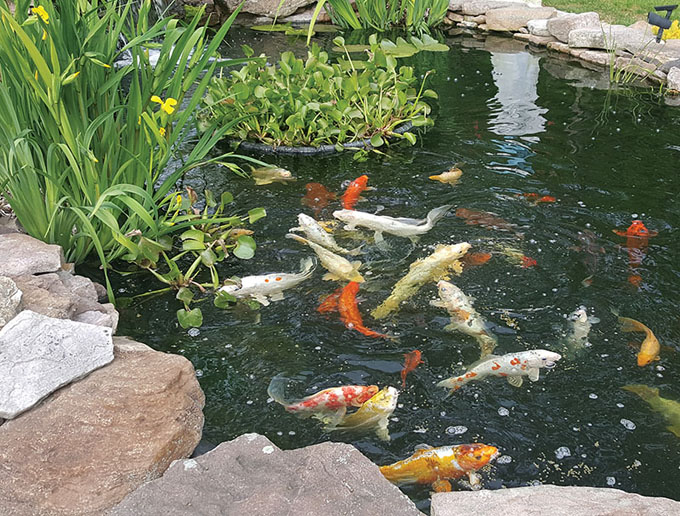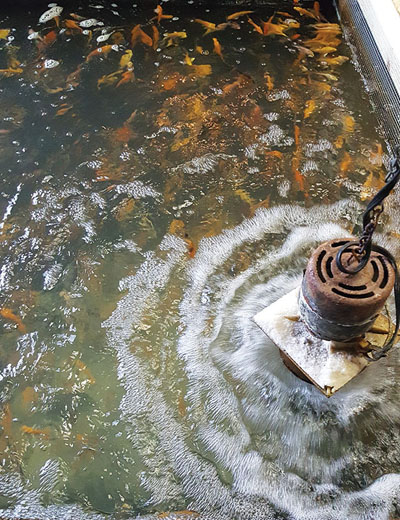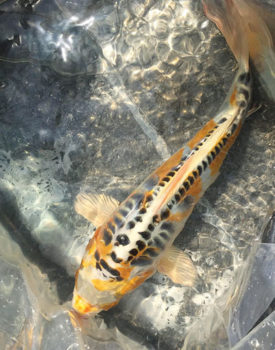
One of the most important yet overlooked aspects to maintaining healthy koi is optimizing water quality. Although testing the water may be viewed as too expensive or time-consuming, it is still a necessary task to ensure healthy koi. Could you imagine living in a place where the air you breathe is so contaminated to the point that it makes you sick and decreases your immune response to infection? Or, imagine the oxygen level in the air being decreased to the point that you struggle to breathe. You wouldn’t want to live in a place like that, and neither do your koi. Regular water-quality checks can ensure your koi live a long, healthy life.
The Water Source
The water source that feeds your pond can have an impact on the overall health of your fish. If your water comes from a well, it is more than likely low in dissolved oxygen. Depending on what area you are in, you could also have supersaturation of other gases such as hydrogen sulfide, which can be detrimental to your fish even at fairly low concentrations. A positive of using well water is that it is usually rather low in suspended solids, keeping your pond clearer and easier to enjoy.
If the water source is coming from town or city water, there is probably chlorine or chloramine added to the water in order to reduce bacteria levels. The level of chlorine or chloramine in the water is more than likely beyond the point your fish can handle. Spring-fed ponds are usually very clear and stay cooler through the summer if the temperature rises outside, but the water entering can be low in dissolved oxygen, as it comes from the ground. Colder water tends to hold more oxygen once diffusion has a chance to occur. However, more than likely, your pond has some type of filter system for clarity and oxygen. A filter can remove toxic, nitrogen-containing compounds such as ammonia, nitrite and nitrate, while some form of aeration can force out supersaturation of unwanted gases and increase dissolved oxygen levels.
What is your Dissolved Oxygen?
Dissolved oxygen will vary throughout the day and night. Early-morning hours are a great time to check your pond’s dissolved oxygen, because this allows you to see your lowest point throughout the cycle of the day. At this time, the dissolved oxygen should be no lower than 3 or 4 parts per million (ppm). While koi will survive at much lower levels of dissolved oxygen for shorter periods of time, it is not healthy for the fish. Low oxygen can contribute to other problems; when fish are stressed in any way, they tend to become more susceptible to parasites and disease.

The saturation point for dissolved oxygen can vary slightly depending on the altitude and temperature. A good rule is to not allow the dissolved oxygen to drop below half the saturation point for a given area.
There are many ways to increase oxygen levels in a pond, but some of the cheaper remedies are pretty simple. Agitation of the water to increase surface area, and thus the diffusion rate, is the most basic and widely used method to increase oxygen levels throughout the night. Be careful of doing this during the day if there are phytoplankton and plants present in the water. Agitation may drive oxygen out if the water becomes super-saturated from photosynthesis. It is always a good idea to keep track of your dissolved oxygen levels if you think you might be having problems.
What is your pH?
The pH will vary slightly throughout the day. To keep your koi healthy, you should try to keep your pH between 7 and 8. Outside that range, koi will start to stress and therefore will become more susceptible to disease and parasites. Large pH swings can indicate that the alkalinity is not where it needs to be.
Alkalinity
The pH will swing much more throughout the day if your alkalinity is low. Alkalinity is consumed during the nitrogen cycle when toxic forms of nitrogen are converted to less toxic forms that plants can uptake. The alkalinity of a pond should not get below 40 ppm under any circumstance, or the pH will swing, and the koi may become stressed. It is not uncommon to see koi do just fine in water where the alkalinity is as high as 200 ppm, but it shouldn’t be much higher than that. In a larger pond, alkalinity can be increased fairly easily with any form of lime. In a smaller pond, alkalinity is increased very efficiently with sodium bicarbonate.
The Nitrogen Cycle
Unlike mammals who excrete urea, fish excrete ammonia due to the abundance of water around to dilute this highly toxic compound. The problem comes when the level of ammonia rises before it is able to be converted. The total ammonia nitrogen can be obtained with a test kit. This is a measure of all the nitrogen that is present in the ammonia. To find the level of toxic ammonia, the pH and temperature of the water is needed. If you have a test kit, it should explain how to calculate this value. Toxic ammonia can be harmful for your koi at very low levels — much less than 1 ppm.

Nitrogen-fixing plants or filters are a good strategy to cope with this stressor. If an immediate solution is necessary, such as in the case of very stressed and sick fish, temperature manipulation and water exchanges can be used.
Is Your Water Clear?
Along with not allowing you to see your beautiful koi in your pond as well as you wish you could, turbidity can cause some other unseen problems. The suspended solids in the water can cause oxygen to not dissolve as readily as it would in water that has less turbidity. A good filter system will often take care of any issue you would have with turbidity. Some aquatic plants are effective at removing turbidity in water as well. Overfeeding can cause some turbidity issues if the organic matter from the feed is able to dissolve into the water.
I recommend trying to test your water on some kind of a schedule and keep records of your results. Testing in the morning and in the evening will give you the best viewpoints. Keeping records will allow you to see the changes in your pond over time. Some changes may be seasonal, but if your fish begin to look sick, you can go back and view the changes. Once the problem is identified, it can be fixed much more swiftly and cost-effectively than the trial-and-error method. If you do see a change that concerns you, call someone with experience in water gardens or pondscapes to help interpret your results. Testing your water once a month is better than not testing it at all. Your koi will love you for their improved health.


